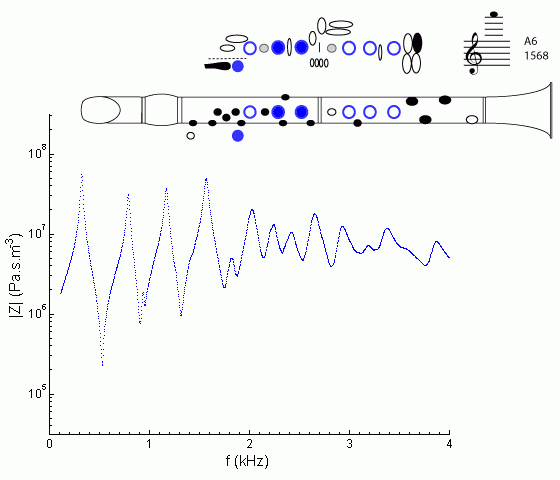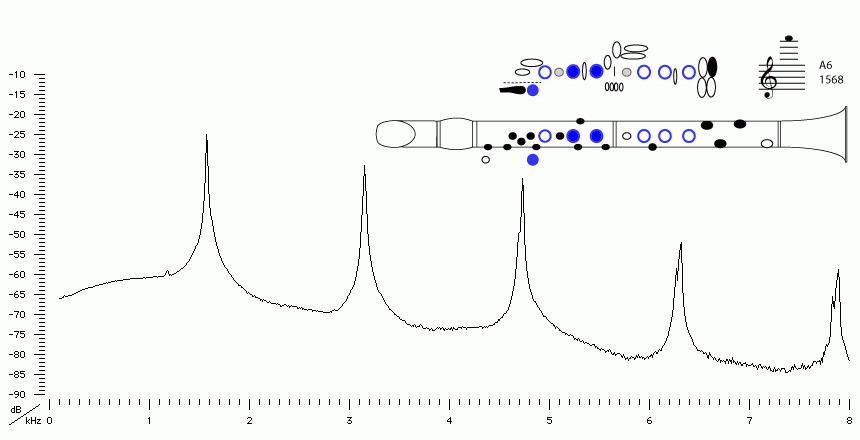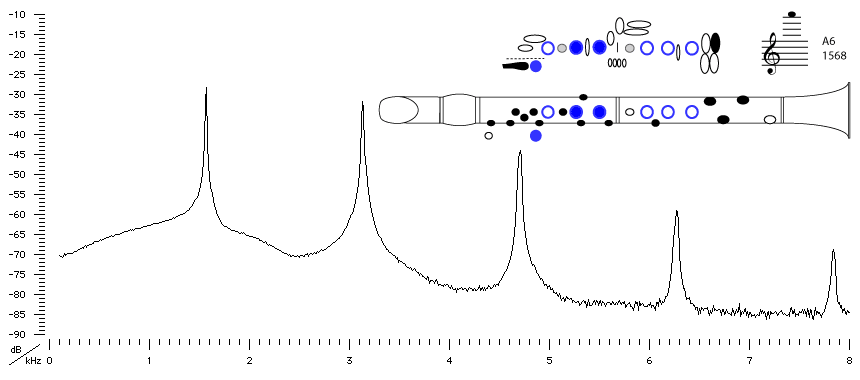| Acoustics of the clarinet |
Bb clarinet |
A6 |

|
Fingering Acoustic schematic Non-specialist introduction
to acoustic impedance Notes are the written pitch. |
This is very nearly the same fingering as for E6 (it doesn't have the extra venting with the G#/D# key) and is very similar to that for C4 and G5. The open register holes lower and displace the first two peaks substantially, and that of the third peak less substantially. So of course you have to watch that it doesn't 'fall down' to a pitch near that third peak (near E6). With the first, third and fifth harmonics out of the way, we get something close to the 7th harmonic of C4. This would normally be a very flat minor twenty-first above C4 (two octaves and a flat minor seventh - see the sound spectrum for C4), however the positioning of the register holes and effects of the bore downstream flattens it more or less into tune at a major twentieth (two octaves and a sixth).
In the sound spectra below, note that there is no longer any systematic differences among odd and even harmonics. At low frequencies, the resonances of the clarinet bore support the odd harmonics more, but at frequencies above the cut-off frequency for the clarinet, there are usually no bore resonances (ie peaks in the impedance spectrum) to support harmonics. The reed can produce both odd and even harmonics, and these are radiated by the clarinet, which acts a little like a megaphone at these frequencies.

Sound spectrum
of a Bb clarinet
played using fingering for A6
forte .
For more explanation, see
Introduction to clarinet acoustics
For this note (and also for E3, F3 and G4), we show spectra for different loudness or dynamic level (f, mp and pp). Note that the main distinguishing feature of a loud note is that more high harmonics appear and that the harmonics already present become stronger. The more and stronger harmonics change the timbre of the sound, making it brighter or less mellow: listen to the sound files. They are also very effective at making it louder, because our ears are most sensitive in the range 1-4 kHz. (See What is a decibel?) Note also that the base line for all spectra is a broad band 'noise' containing all frequencies. This is due to the turbulence of air passing through the reed opening, and it is an important part of the characteristic clarinet sound, particularly at the beginning of a note.
For a discussion of how the reed motion produces different timbre and dynamic levels, see Playing softly and loudly.

Sound spectrum
of a Bb clarinet played using fingering for A6 mezzopiano.
![]()
![]() You can hear A6 mezzopiano played on a Bb clarinet.
You can hear A6 mezzopiano played on a Bb clarinet.

Sound spectrum
of a Bb clarinet played using fingering for A6 pianissimo.
For more explanation, see Introduction
to clarinet acoustics
![]()
![]() You can hear A6 pianissimo played on a Bb clarinet.
You can hear A6 pianissimo played on a Bb clarinet.
|
Contact:
Joe Wolfe
/ J.Wolfe@unsw.edu.au |